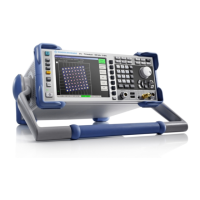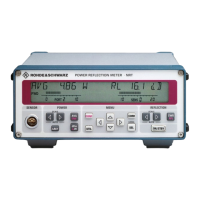R&S FSH Two-port measurements with the tracking generator
1309.6275.12 4.55 E-2
The R&S FSH displays the DUT's phase characteristic
a
s a function of the frequency REFLECTION VECTOR
(CAL) PHASE will appear in the upper area of the
display. In the default scaling, the phase can only have
values between -200° and +200°.
Note: In the diagram's default scaling of -200° to
+200°, the trace will be shown correctly only if the
p
hase difference between two adjacent test points is
less than 180°.
You can shift the reference of the phase measurement, for example to move the test trace to the center
of the screen.
Press the AMPT key.
Press the REF POSITION softkey.
Using the rotary knob or the cursor keys, change
the reference position or enter a new reference
position by using the numeric keys.
Confirm by pressing the ENTER key or the REF
POSITION softkey.
Supplying DC voltage to active DUTs (models with integrated VSWR bridge
only)
By using the R&S FHS, DC voltage can be supplied to active DUTs such as amplifiers through the
integrated bias tees (BIAS 1 and BIAS 2) via the RF cable. The DC voltage is fed in from a suitable
external power supply (max. 600 mA/max. 50 V). To measure the antenna coupling of mobile radio
base stations, the DC voltage must be supplied to two tower-mounted amplifiers (TMA). This is done by
applying a suitable voltage at the BIAS 1 and BIAS 2 BNC inputs of the VSWR bridge.
Scalar measurement of reflection
The test setup must be calibrated before any measurements are made. This is done with a short and an
open at the point were the reflection measurement is to be made. If a cable is to be inserted between
the DUT and the bridge, perform the calibration at the measurement end of the cable.

